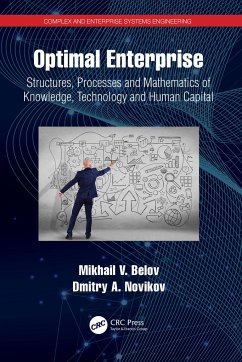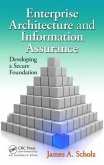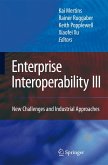Mikhail V Belov, Dmitry A Novikov
Optimal Enterprise
Structures, Processes and Mathematics of Knowledge, Technology and Human Capital
Mikhail V Belov, Dmitry A Novikov
Optimal Enterprise
Structures, Processes and Mathematics of Knowledge, Technology and Human Capital
- Gebundenes Buch
- Merkliste
- Auf die Merkliste
- Bewerten Bewerten
- Teilen
- Produkt teilen
- Produkterinnerung
- Produkterinnerung
The approach in this book looks at Enterprise Systems, and their fundamental characteristics, as a complex sociotechnical system and an integrated set of structural and process models that each need to be studied as composite parts of the whole.
Andere Kunden interessierten sich auch für
![Sustainable Enterprise Architecture Sustainable Enterprise Architecture]() Kirk HausmanSustainable Enterprise Architecture115,99 €
Kirk HausmanSustainable Enterprise Architecture115,99 €![Enterprise Architecture A to Z Enterprise Architecture A to Z]() Daniel MinoliEnterprise Architecture A to Z149,99 €
Daniel MinoliEnterprise Architecture A to Z149,99 €![Managing Customer Relationships Using Customer Care Techniques Managing Customer Relationships Using Customer Care Techniques]() Anna BrzozowskaManaging Customer Relationships Using Customer Care Techniques139,99 €
Anna BrzozowskaManaging Customer Relationships Using Customer Care Techniques139,99 €![Big Data Strategies for Agile Business Big Data Strategies for Agile Business]() Bhuvan UnhelkarBig Data Strategies for Agile Business158,99 €
Bhuvan UnhelkarBig Data Strategies for Agile Business158,99 €![Enterprise Architecture and Information Assurance Enterprise Architecture and Information Assurance]() James A ScholzEnterprise Architecture and Information Assurance102,99 €
James A ScholzEnterprise Architecture and Information Assurance102,99 €![Enterprise Interoperability III Enterprise Interoperability III]() Kai Mertins / Rainer Ruggaber / Keith Popplewell / Xiaofei Xu (eds.)Enterprise Interoperability III224,99 €
Kai Mertins / Rainer Ruggaber / Keith Popplewell / Xiaofei Xu (eds.)Enterprise Interoperability III224,99 €![Digital Enterprise Challenges Digital Enterprise Challenges]() George L. Kov cs / Peter Bert¢k / G‚za Haidegger (Hgg.)Digital Enterprise Challenges227,99 €
George L. Kov cs / Peter Bert¢k / G‚za Haidegger (Hgg.)Digital Enterprise Challenges227,99 €-
-
-
The approach in this book looks at Enterprise Systems, and their fundamental characteristics, as a complex sociotechnical system and an integrated set of structural and process models that each need to be studied as composite parts of the whole.
Hinweis: Dieser Artikel kann nur an eine deutsche Lieferadresse ausgeliefert werden.
Hinweis: Dieser Artikel kann nur an eine deutsche Lieferadresse ausgeliefert werden.
Produktdetails
- Produktdetails
- Verlag: CRC Press
- Seitenzahl: 350
- Erscheinungstermin: 29. Juli 2021
- Englisch
- Abmessung: 234mm x 156mm x 22mm
- Gewicht: 699g
- ISBN-13: 9780367652432
- ISBN-10: 0367652439
- Artikelnr.: 60601631
- Herstellerkennzeichnung
- Libri GmbH
- Europaallee 1
- 36244 Bad Hersfeld
- gpsr@libri.de
- Verlag: CRC Press
- Seitenzahl: 350
- Erscheinungstermin: 29. Juli 2021
- Englisch
- Abmessung: 234mm x 156mm x 22mm
- Gewicht: 699g
- ISBN-13: 9780367652432
- ISBN-10: 0367652439
- Artikelnr.: 60601631
- Herstellerkennzeichnung
- Libri GmbH
- Europaallee 1
- 36244 Bad Hersfeld
- gpsr@libri.de
Mikhail Belov is Deputy CEO of IBS, responsible for new technology and business development in the area of engineering IT systems, PLM and other industrial IT systems. His 38-year career has centered on systems engineering, operations research, economics and finance, IT, electronics. Mikhail was Vice-President of Metrosvyaz, Deputy Finance Director of TOKOBANK, and President & Owner of Geliosoft Consulting, a startup company focused on cutting-edge technologies, such as an ultra-wideband multi-radar system. Mikhail holds an MS in electronics from Moscow Engineering Physics Institute and a PhD in operations research and applied math statistics from the Central Scientific Research Institute. Doctor of Science (Techn.), he also holds an MBA in finance. Dmitry Novikov is director of Institute of Control Sciences of Russian Academy of Sciences. His scientific interests cover: Control Theory, Cybernetics, Game Theory, Decision-making, Collective Behavior. More than 500 publications (see the full publication history), including more than 20 monographs (Springer, CRC, etc), textbooks and brochures; more than 100 papers in leading journals. He has more than 25 year's extensive experience in the field of scientific and technological projects and company management (manufacturing sphere, research, teaching, consulting). Dmitry is Doctor of Science (Techn.), Professor, Corresponding member of Russian Academy of Sciences, Head of Control Sciences Department of Moscow Institute of Physics and Technology
Part I. Methodology. Foundations of Enterprise Control
Chapter 1 Enterprise and Complex Activity. Qualitative models
1.1 Introduction
1.2 Structural models of complex activity and Enterprise
1.3 Uncertainty and creation of elements of complex activity
1.4 Lifecycles of complex activity
1.5 Implementation of the management processes
1.6 Conclusion
References
Chapter 2 Enterprise management and lifecycles compatibility
2.1 A sociotechnical system, complex activity, and purposefulness
2.2 Subject matter of Enterprise management
2.3 Means of and factors involved in Enterprise management
2.4 Ordering of management actions along the lifecycle of complex activity
2.5 Compatibility of complex activity lifecycles
2.6 Conclusion
References
Part II. Mathematics. Mathematical models and methods of Enterprise Control
Chapter 3 Enterprise Control Problem - the Statement
3.1 Concept of optimization
3.2 Enterprise Control Problem - qualitative model
3.3 Enterprise Control Problem among related knowledge domains
3.4 Enterprise Control Problem as an optimization problem
3.5 Conclusion
References
Chapter 4 Contracts
4.1 Static principal - agent models
4.2 Static multi-agent models
4.3 Dynamic multi-agent models
4.4 Conclusion
References
Chapter 5 Technology
5.1 Technology management problem
5.2 Known models and methods in related scientific domains
5.3 Technology evolution and management
5.4 Integration of technology components
5.5 Technology in an external environment
5.6 Conclusion
Appendixes
References
Chapter 6 Human capital
6.1 Problem of human capital management
6.2 Pools of active resources as a formal representation of human capital
6.3 Statistics of the active resource traffic
6.4 Conclusion
Appendixes
References
Chapter 7 Planning
7.1 Algorithmic models of planning process in hierarchical dynamic
multi-agent active system
7.2 Planning of transition from design phase to execution phase in dynamic
active system
7.3 Planning and control in dynamic multi-agent active system with changing
characteristics
7.4 Planning of Human Capital
7.5 Conclusion
Appendixes
References
Part III. Practice. Business Tools and Applications
Chapter 8 Optimal Enterprise Control Framework and Practical Implementation
8.1 Optimal Enterprise Control Framework
8.2 Some applications of contracts
8.3 Practical technology development optimization
8.4 Optimal planning in practice
8.5 Conclusion
Appendixes
References
Afterword
Subject Index
Chapter 1 Enterprise and Complex Activity. Qualitative models
1.1 Introduction
1.2 Structural models of complex activity and Enterprise
1.3 Uncertainty and creation of elements of complex activity
1.4 Lifecycles of complex activity
1.5 Implementation of the management processes
1.6 Conclusion
References
Chapter 2 Enterprise management and lifecycles compatibility
2.1 A sociotechnical system, complex activity, and purposefulness
2.2 Subject matter of Enterprise management
2.3 Means of and factors involved in Enterprise management
2.4 Ordering of management actions along the lifecycle of complex activity
2.5 Compatibility of complex activity lifecycles
2.6 Conclusion
References
Part II. Mathematics. Mathematical models and methods of Enterprise Control
Chapter 3 Enterprise Control Problem - the Statement
3.1 Concept of optimization
3.2 Enterprise Control Problem - qualitative model
3.3 Enterprise Control Problem among related knowledge domains
3.4 Enterprise Control Problem as an optimization problem
3.5 Conclusion
References
Chapter 4 Contracts
4.1 Static principal - agent models
4.2 Static multi-agent models
4.3 Dynamic multi-agent models
4.4 Conclusion
References
Chapter 5 Technology
5.1 Technology management problem
5.2 Known models and methods in related scientific domains
5.3 Technology evolution and management
5.4 Integration of technology components
5.5 Technology in an external environment
5.6 Conclusion
Appendixes
References
Chapter 6 Human capital
6.1 Problem of human capital management
6.2 Pools of active resources as a formal representation of human capital
6.3 Statistics of the active resource traffic
6.4 Conclusion
Appendixes
References
Chapter 7 Planning
7.1 Algorithmic models of planning process in hierarchical dynamic
multi-agent active system
7.2 Planning of transition from design phase to execution phase in dynamic
active system
7.3 Planning and control in dynamic multi-agent active system with changing
characteristics
7.4 Planning of Human Capital
7.5 Conclusion
Appendixes
References
Part III. Practice. Business Tools and Applications
Chapter 8 Optimal Enterprise Control Framework and Practical Implementation
8.1 Optimal Enterprise Control Framework
8.2 Some applications of contracts
8.3 Practical technology development optimization
8.4 Optimal planning in practice
8.5 Conclusion
Appendixes
References
Afterword
Subject Index
Part I. Methodology. Foundations of Enterprise Control
Chapter 1 Enterprise and Complex Activity. Qualitative models
1.1 Introduction
1.2 Structural models of complex activity and Enterprise
1.3 Uncertainty and creation of elements of complex activity
1.4 Lifecycles of complex activity
1.5 Implementation of the management processes
1.6 Conclusion
References
Chapter 2 Enterprise management and lifecycles compatibility
2.1 A sociotechnical system, complex activity, and purposefulness
2.2 Subject matter of Enterprise management
2.3 Means of and factors involved in Enterprise management
2.4 Ordering of management actions along the lifecycle of complex activity
2.5 Compatibility of complex activity lifecycles
2.6 Conclusion
References
Part II. Mathematics. Mathematical models and methods of Enterprise Control
Chapter 3 Enterprise Control Problem - the Statement
3.1 Concept of optimization
3.2 Enterprise Control Problem - qualitative model
3.3 Enterprise Control Problem among related knowledge domains
3.4 Enterprise Control Problem as an optimization problem
3.5 Conclusion
References
Chapter 4 Contracts
4.1 Static principal - agent models
4.2 Static multi-agent models
4.3 Dynamic multi-agent models
4.4 Conclusion
References
Chapter 5 Technology
5.1 Technology management problem
5.2 Known models and methods in related scientific domains
5.3 Technology evolution and management
5.4 Integration of technology components
5.5 Technology in an external environment
5.6 Conclusion
Appendixes
References
Chapter 6 Human capital
6.1 Problem of human capital management
6.2 Pools of active resources as a formal representation of human capital
6.3 Statistics of the active resource traffic
6.4 Conclusion
Appendixes
References
Chapter 7 Planning
7.1 Algorithmic models of planning process in hierarchical dynamic
multi-agent active system
7.2 Planning of transition from design phase to execution phase in dynamic
active system
7.3 Planning and control in dynamic multi-agent active system with changing
characteristics
7.4 Planning of Human Capital
7.5 Conclusion
Appendixes
References
Part III. Practice. Business Tools and Applications
Chapter 8 Optimal Enterprise Control Framework and Practical Implementation
8.1 Optimal Enterprise Control Framework
8.2 Some applications of contracts
8.3 Practical technology development optimization
8.4 Optimal planning in practice
8.5 Conclusion
Appendixes
References
Afterword
Subject Index
Chapter 1 Enterprise and Complex Activity. Qualitative models
1.1 Introduction
1.2 Structural models of complex activity and Enterprise
1.3 Uncertainty and creation of elements of complex activity
1.4 Lifecycles of complex activity
1.5 Implementation of the management processes
1.6 Conclusion
References
Chapter 2 Enterprise management and lifecycles compatibility
2.1 A sociotechnical system, complex activity, and purposefulness
2.2 Subject matter of Enterprise management
2.3 Means of and factors involved in Enterprise management
2.4 Ordering of management actions along the lifecycle of complex activity
2.5 Compatibility of complex activity lifecycles
2.6 Conclusion
References
Part II. Mathematics. Mathematical models and methods of Enterprise Control
Chapter 3 Enterprise Control Problem - the Statement
3.1 Concept of optimization
3.2 Enterprise Control Problem - qualitative model
3.3 Enterprise Control Problem among related knowledge domains
3.4 Enterprise Control Problem as an optimization problem
3.5 Conclusion
References
Chapter 4 Contracts
4.1 Static principal - agent models
4.2 Static multi-agent models
4.3 Dynamic multi-agent models
4.4 Conclusion
References
Chapter 5 Technology
5.1 Technology management problem
5.2 Known models and methods in related scientific domains
5.3 Technology evolution and management
5.4 Integration of technology components
5.5 Technology in an external environment
5.6 Conclusion
Appendixes
References
Chapter 6 Human capital
6.1 Problem of human capital management
6.2 Pools of active resources as a formal representation of human capital
6.3 Statistics of the active resource traffic
6.4 Conclusion
Appendixes
References
Chapter 7 Planning
7.1 Algorithmic models of planning process in hierarchical dynamic
multi-agent active system
7.2 Planning of transition from design phase to execution phase in dynamic
active system
7.3 Planning and control in dynamic multi-agent active system with changing
characteristics
7.4 Planning of Human Capital
7.5 Conclusion
Appendixes
References
Part III. Practice. Business Tools and Applications
Chapter 8 Optimal Enterprise Control Framework and Practical Implementation
8.1 Optimal Enterprise Control Framework
8.2 Some applications of contracts
8.3 Practical technology development optimization
8.4 Optimal planning in practice
8.5 Conclusion
Appendixes
References
Afterword
Subject Index








